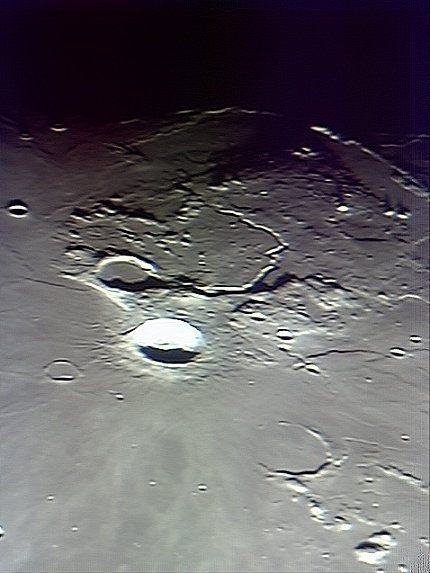
Named after the ancient Greek astronomer Aristarchus of
Samos, this crater is both an observer's delight and a photographer's nightmare. Crater Aristarchus is a relatively
small crater with a diameter of only 40.0 km and, yet, is the brightest feature on the surface of the moon and is
visible even during Earthshine. Aristarchus is also a very young crater, believed to be less than 500 million years
old; is the center of various bright ray systems; the source of various reported lunar transient phenomenon; and lies
in an area rich in color, three-dimensional features and possible volcanic activity. Immediately to the north of
Aristarchus and its neighbour, Herodotus, lies the largest rille on the lunar surface (Vallis Schroeteri) measuring 160
km in length, up to 11 km in width and 1 km in depth as well as the Aristarchus Plateau, a region measuring
approximately 170 by 200 km, and whose 2 km elevation during small windows of opportunities each lunation provide a
surreal experience to the observer.
Note: For additional details in relation to the Aristarchus region, click
here.
|
Crater: Aristarchus Quadrant: N/W Lunar Coordinates: 23.7° N 47.4° W Diameter: 40.0 km Height: 3.0 km Lunation Age: 12d 10h 04m Phase: 93.9° Diameter: 31.47' Magnitude: -12.0 Rukl: 18 |
 |
Date: Oct 25, 2004 20:46 - 21:08 UT+3 Location: Athens, Greece Equipment: Celestron 14" SCT Losmandy G-11 GEM Philips ToUCam PCVC 740k Video Imaging: 06 AVI @ 05 fps (0997 frames) 18 AVI @ 10 fps (5228 frames)
Software: K3CCDTools V1.0.6.460 AVI Joiner V1.02 Registax V2.1.0.0 Photoshop V6 Processing: Selective Sampling (244/6225) Registration & Alignment Stacking Average Combine JPG Compression |
